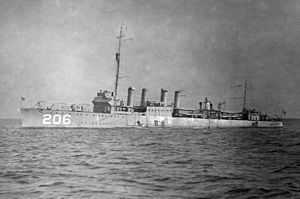Commissioned 5 September 1919 Struck 5 December 1945 Launched 19 March 1919 Builder William Cramp & Sons | Laid down 19 August 1918 Decommissioned 12 November 1945 Construction started 19 August 1918 Displacement 1.102 million kg | |
 | ||
Reclassified as DMS-9 on 19 November 1940, and AG-108, on 5 June 1945 | ||
USS Chandler (DD-206/DMS-9/AG-108) was a Clemson-class destroyer in the United States Navy. She was the only ship named for William Eaton Chandler, who served as Secretary of the Navy from 1882 to 1886.
Contents
Chandler was launched on 19 March 1919 by William Cramp and Sons Ship and Engine Building Company; sponsored by Mrs. L. H. Chandler; and commissioned 5 September, Lieutenant Commander F. Cogswell in command.
1920s
Assigned to Destroyer Squadron 3 of the U.S. Atlantic Fleet, Chandler sailed from Newport, Rhode Island, 19 December for duty with U.S. Naval Forces, Turkey. After carrying a diplomatic mission to the Crimea, and aiding the American Red Cross in its relief work with Russia refugees, Chandler joined the U.S. Naval Detachment, Adriatic. She served as station ship at Venice and had relief duty throughout the Adriatic until January 1921.
Sailing through the Suez Canal, Chandler arrived at Cavite, on 15 February 1921. She served with the Asiatic Fleet, protecting American interests throughout the Far East, until on 25 August 1922. Clearing Chefoo, China, she arrived at San Francisco 30 September. She was decommissioned on 20 October 1922, and placed in reserve at Mare Island Navy Yard.
1930s
Chandler was recommissioned on 31 March 1930 for operations off the west coast, Hawaii, the Panama Canal Zone, and in the Caribbean. In 1934, she sailed to New York for the Presidential Fleet Review of 31 May. In 1936 she took part in radio sound tests, and in 1940, served as plane guard during the flight of the Secretary of the Navy to Hawaii.
Destroyer minesweeper (DMS)
Reporting to Mare Island Navy Yard in October 1940, Chandler was reclassified DMS-9 on 19 November, and converted to a high-speed minesweeper. She arrived at Pearl Harbor on 12 February 1941 to begin operational training and patrol. At sea when the attack on Pearl Harbor occurred, she returned to base 2 days later. Until on 30 June 1942, she escorted convoys to San Francisco, Palmyra Atoll, Christmas, and Midway Islands, and swept and patrolled in Hawaiian waters.
While en route to operations in the Aleutians on 27 July, she collided with Lamberton in a heavy fog, so Chandler underwent repair from 11 August to 27 September at Mare Island Navy Yard. On 5 October, she reported at Dutch Harbor for duty patrolling and escorting convoys in the Aleutians. In May 1943, she covered the landings at Attu, and in August, those at Kiska. Leaving the fog and difficult waters of the Aleutians behind in October, Chandler was readied at San Francisco for duty farther south in the Pacific.
Chandler docked at Pearl Harbor on 1 January. From there, in a succession of landings, at Majuro (31 January), Eniwetok (17 February-6 March), Saipan (13 June-20 July), and Tinian (21 July-24 July), she swept mines and screened assault shipping. Patrolling each invasion area as the operation developed, Chandler joined with Newcomb in sinking the Japanese submarine I-185 on 22 June, at 15°55′N., 147°09′E.
On 17 October 1944, Chandler resumed mine-sweeping in landings, as she sailed into Leyte Gulf in advance of the major force for the assault to sweep a path for the attacking amphibious ships. She remained on duty, sweeping, patrolling, and screening, through the start of the landings, retiring on 25 October for Manus after the delay caused by the Battle for Leyte Gulf.
Called upon for similar duty in the Lingayen operation, Chandler came under heavy fire from Japanese aircraft on the night of 6–7 January 1945. Fire from Chandler and Hovey shot down a Japanese aircraft, but only after it had launched a torpedo, which struck Hovey, sinking her within 3 minutes. Chandler stood by, recovering 229 officers and men from Hovey. At the time Hovey was carrying survivors of the USS Long she had rescued previously. Chandler remained on duty in Lingayen Gulf until 10 January, when she cleared for convoy escort operations through mid-February. At Iwo Jima from 16 February to 28 February, she gave her experienced aid in sweeping, patrolling, and screening for the buildup and the subsequent assault.
Fate
Chandler returned to the west coast for overhaul in April. While there, she was reclassified AG-108, on 5 June 1945, and after training, she began a tour of towing targets in gunnery exercises for new ships engaged in shakedown training. While performing this important task, she based on both San Diego and Pearl Harbor. After the end of hostilities, Chandler proceeded to Norfolk, Virginia, arriving on 21 October 1945. There she was decommissioned on 21 November 1945, and sold on 18 November 1946.
Awards
Chandler received eight battle stars for service in World War II.
